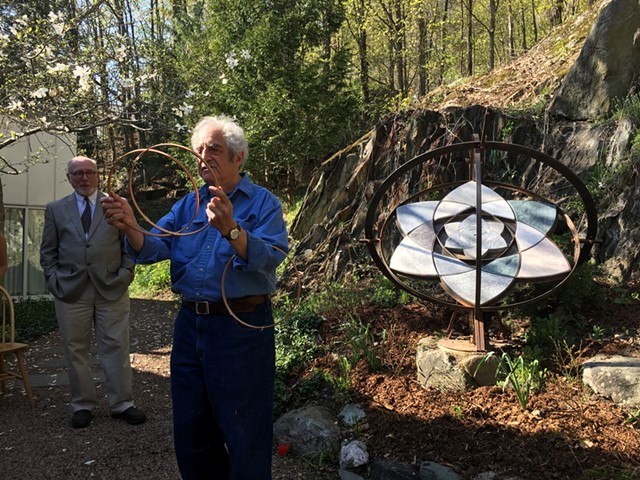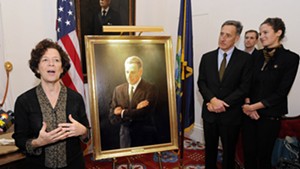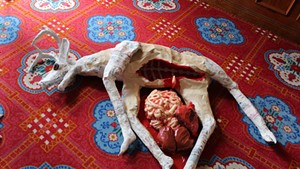
- John Walters
- Paul Calter, right, with his sculpture "Trillium" as state curator David Schütz looks on.
A group of gardeners and art aficionados gathered Wednesday afternoon to celebrate one of Montpelier's hidden gems — a garden of native Vermont plants behind the Statehouse, and a recently installed sculpture that serves as its focal point.
The garden takes advantage of the dramatic topography provided by the base of Hubbard Hill, which rises directly behind the Statehouse. "This garden really, really helps make good policy in Vermont," said House Speaker Mitzi Johnson (D-South Hero), whose office windows look out on the garden. "It’s a huge gift, to have this right in our backyard."
The sculpture,"Trillium," was created by Randolph artist and mathematician Paul Calter, who wielded three wooden hoops to explain how the design came to be.
"It's based entirely on the circle, the perfect geometric shape," he said, as he used the hoops to illustrate how three circles, aligned properly, form a six-pointed star. That became the motif of the sculpture: A six-pointed star within a six-pointed star, framed by a pair of metal circles.
His second inspiration came from nature. "I wanted a flower," Calter said. "I looked through George Aiken’s
Pioneering with Wildflowers. He had a whole chapter on the trillium."
Yes, he means
that George Aiken. The late senator and governor was a horticulturist before entering politics, and wrote a book about wildflowers that was published in 1935.
The trillium combined Calter's mathematical concept with its planned placement in a garden. And it fits the spot so perfectly that it might force a change in plans. State curator David Schütz explained that the location was meant to be the setting for a rotating series of artworks, "But the beauty and skill of this piece may make us change our minds ... It moved an old curator."
Schütz also recounted the garden's backstory. It was originally crafted in 1986 after the cafeteria was built. But "decades went by, and this became a place to honor Vermont’s invasives," he said.
In 2006, master gardener Loring Starr and professional landscape gardener Jean Vissering, both residents of East Montpelier, suggested turning the neglected space into a display of native plants. "The Statehouse grounds crew was not involved," said Schütz. "An amazing amount of volunteer labor went into this."
The result is a small oasis tucked right behind the Statehouse, in full view of the often preoccupied lawmakers, officials, lobbyists and reporters who frequent the cafeteria. But for those who take the time and look, it provides a bit of tranquility and a reminder that there's a lot more to this planet than hearings, debates and legislation.















Comments
Comments are closed.
From 2014-2020, Seven Days allowed readers to comment on all stories posted on our website. While we've appreciated the suggestions and insights, right now Seven Days is prioritizing our core mission — producing high-quality, responsible local journalism — over moderating online debates between readers.
To criticize, correct or praise our reporting, please send us a letter to the editor or send us a tip. We’ll check it out and report the results.
Online comments may return when we have better tech tools for managing them. Thanks for reading.